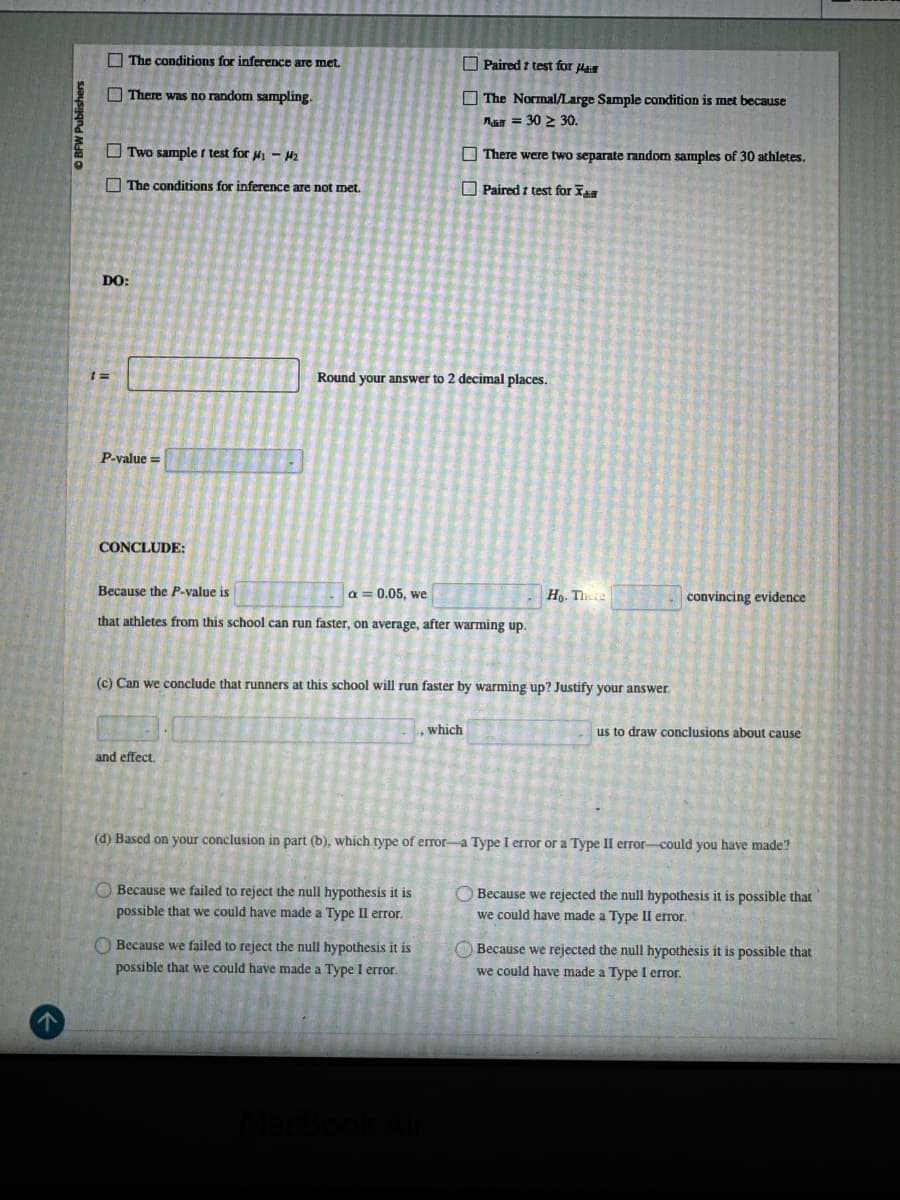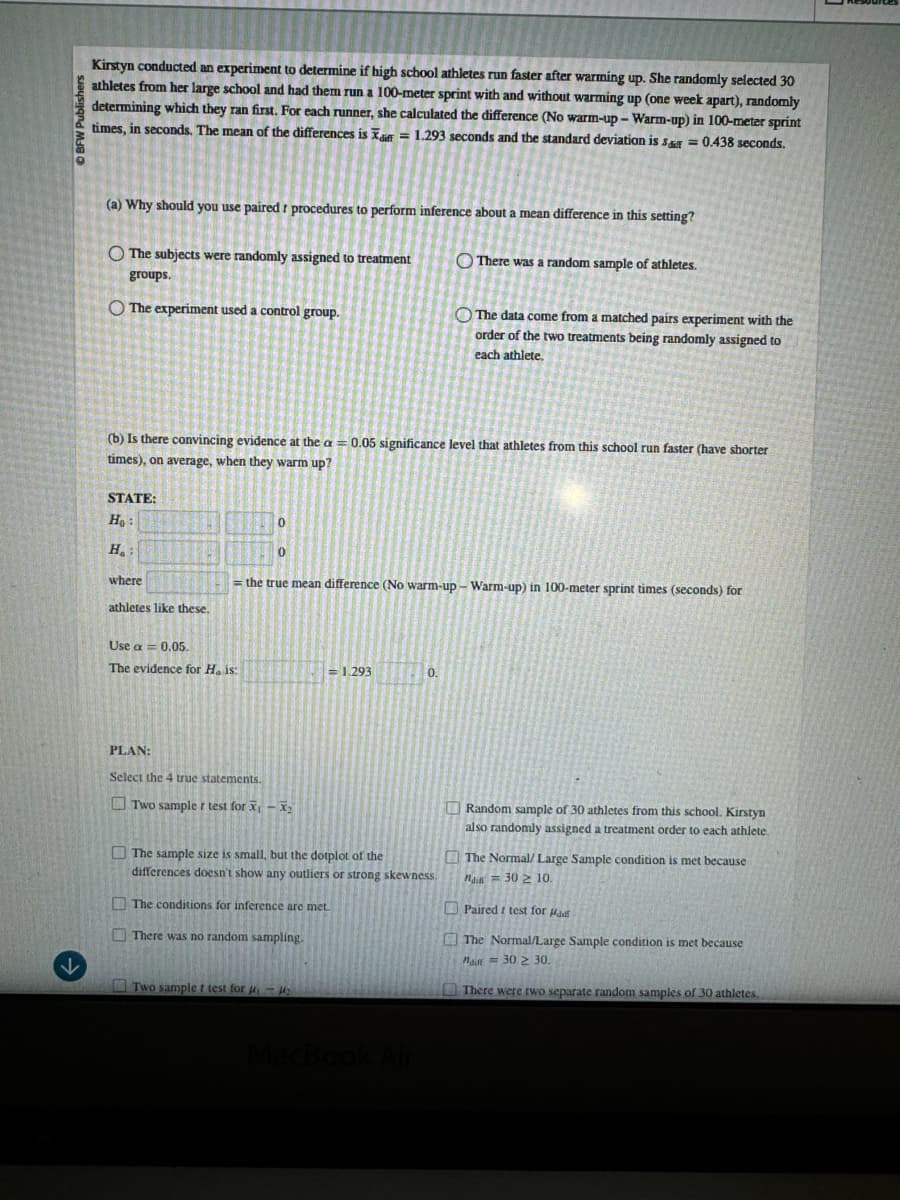Kirstyn conducted an experiment to determine if high school athletes run faster after warming up. She randomly selected 30- athletes from her large school and had them run a 100-meter sprint with and without warming up (one week apart), randoml determining which they ran first. For each runner, she calculated the difference (No warm-up- Warm-up) in 100-meter sprim times, in seconds. The mean of the differences is an = 1.293 seconds and the standard deviation is sar 0.438 seconds. (a) Why should you use paired t procedures to perform inference about a mean difference in this setting? The subjects were randomly assigned to treatment groups. O The experiment used a control group. There was a random sample of athletes. The data come from a matched pairs experiment with the order of the two treatments being randomly assigned to each athlete. (b) Is there convincing evidence at the a=0.05 significance level that athletes from this school run faster (have shorter times), on average, when they warm up? STATE: Ho H where athletes like these. Use a =0.05. 0 0 the true mean difference (No warm-up- Warm-up) in 100-meter sprint times (seconds) for The evidence for Ha is: -1.293 0.
Kirstyn conducted an experiment to determine if high school athletes run faster after warming up. She randomly selected 30- athletes from her large school and had them run a 100-meter sprint with and without warming up (one week apart), randoml determining which they ran first. For each runner, she calculated the difference (No warm-up- Warm-up) in 100-meter sprim times, in seconds. The mean of the differences is an = 1.293 seconds and the standard deviation is sar 0.438 seconds. (a) Why should you use paired t procedures to perform inference about a mean difference in this setting? The subjects were randomly assigned to treatment groups. O The experiment used a control group. There was a random sample of athletes. The data come from a matched pairs experiment with the order of the two treatments being randomly assigned to each athlete. (b) Is there convincing evidence at the a=0.05 significance level that athletes from this school run faster (have shorter times), on average, when they warm up? STATE: Ho H where athletes like these. Use a =0.05. 0 0 the true mean difference (No warm-up- Warm-up) in 100-meter sprint times (seconds) for The evidence for Ha is: -1.293 0.
Glencoe Algebra 1, Student Edition, 9780079039897, 0079039898, 2018
18th Edition
ISBN:9780079039897
Author:Carter
Publisher:Carter
Chapter10: Statistics
Section10.6: Summarizing Categorical Data
Problem 10CYU
Question
please answer all parts

Transcribed Image Text:DO:
The conditions for inference are met.
There was no random sampling.
Two sample I test for μ₁ - H2
The conditions for inference are not met.
Paired t test for Ha
The Normal/Large Sample condition is met because
a = 30 ≥ 30.
There were two separate random samples of 30 athletes.
Paired t test for Xa
Round your answer to 2 decimal places.
1=
P-value=
CONCLUDE:
Because the P-value is
a = 0.05, we
that athletes from this school can run faster, on average, after warming up.
Ho. There
convincing evidence
(c) Can we conclude that runners at this school will run faster by warming up? Justify your answer.
and effect.
, which
us to draw conclusions about cause
(d) Based on your conclusion in part (b), which type of error-a Type I error or a Type II error-could you have made?
Because we failed to reject the null hypothesis it is
possible that we could have made a Type II error.
Because we failed to reject the null hypothesis it is
possible that we could have made a Type I error.
Because we rejected the null hypothesis it is possible that
we could have made a Type II error.
Because we rejected the null hypothesis it is possible that
we could have made a Type I error.
MacBook Air

Transcribed Image Text:BFW Publishers
Kirstyn conducted an experiment to determine if high school athletes run faster after warming up. She randomly selected 30
athletes from her large school and had them run a 100-meter sprint with and without warming up (one week apart), randomly
determining which they ran first. For each runner, she calculated the difference (No warm-up- Warm-up) in 100-meter sprint
times, in seconds. The mean of the differences is a = 1.293 seconds and the standard deviation is s&r=0.438 seconds.
(a) Why should you use paired t procedures to perform inference about a mean difference in this setting?
The subjects were randomly assigned to treatment
groups.
The experiment used a control group.
There was a random sample of athletes.
The data come from a matched pairs experiment with the
order of the two treatments being randomly assigned to
each athlete.
(b) Is there convincing evidence at the a=0.05 significance level that athletes from this school run faster (have shorter
times), on average, when they warm up?
STATE:
Ho
H.
where
athletes like these.
0
0
=the true mean difference (No warm-up- Warm-up) in 100-meter sprint times (seconds) for
Use a 0.05.
The evidence for H. is:
= 1.293
0.
PLAN:
Select the 4 true statements.
Two sample r test for x-x
The sample size is small, but the dotplot of the
differences doesn't show any outliers or strong skewness.
The conditions for inference are met.
There was no random sampling.
↓
Two sample t test for
MacBook Air
Random sample of 30 athletes from this school. Kirstyn
also randomly assigned a treatment order to each athlete.
The Normal/ Large Sample condition is met because
302 10.
Paired t test for Had
The Normal/Large Sample condition is met because
Mai 30 ≥ 30.
There were two separate random samples of 30 athletes,
Expert Solution
This question has been solved!
Explore an expertly crafted, step-by-step solution for a thorough understanding of key concepts.
This is a popular solution!
Step 1: Write the given information.
VIEWStep 2: Determine the reason for using paired t procedures to perform inference about a mean difference.
VIEWStep 3: State the null and alternate hypothesis for the given scenario.
VIEWStep 4: Compute the test statistics and P-value.
VIEWStep 5: Provide conclusion for the above hypothesis.
VIEWSolution
VIEWTrending now
This is a popular solution!
Step by step
Solved in 6 steps with 16 images

Recommended textbooks for you

Glencoe Algebra 1, Student Edition, 9780079039897…
Algebra
ISBN:
9780079039897
Author:
Carter
Publisher:
McGraw Hill


Holt Mcdougal Larson Pre-algebra: Student Edition…
Algebra
ISBN:
9780547587776
Author:
HOLT MCDOUGAL
Publisher:
HOLT MCDOUGAL

Glencoe Algebra 1, Student Edition, 9780079039897…
Algebra
ISBN:
9780079039897
Author:
Carter
Publisher:
McGraw Hill


Holt Mcdougal Larson Pre-algebra: Student Edition…
Algebra
ISBN:
9780547587776
Author:
HOLT MCDOUGAL
Publisher:
HOLT MCDOUGAL